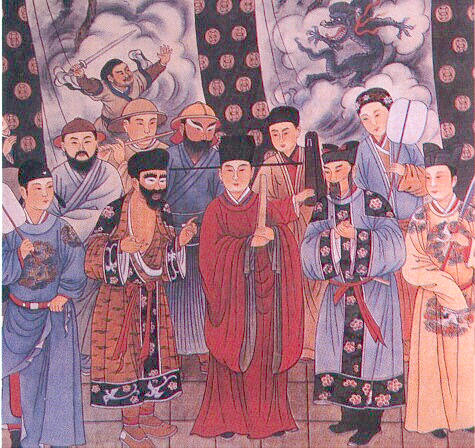
Middle period of feudal society: Sui, Tang, Song, and Yuan Imperial dynasties (581-1368 AD) (Continued)
During much of the Song and Jin dynasties, the country was split into relatively united Southern and Northern parts, each a separately ruled nation, but these regions were finally united under Mongol rule in the Yuan dynasty (1271-1368 AD) established by Kublai Khan (1215-1294), leader of the Mongolian Borjigin clan. This period saw a growth in citizenship in urban areas and the rise of musical genres catering for the urban classes, among them musical forms of story-telling called guzici and zhuanci. There were songs based on extracts from novels, with instrumental accompaniment by drums, clappers, bamboo flutes, and stringed instruments. Further increasing the variety of story-telling genres, musicians composed zhugongdiao, which used a rich set of tunes in each performance (Liao 1964: 85-88). These story-telling genres further evolved into popular ballad genres such as guci and tanci, which still survive in contemporary China.
This period also saw the emergence of full-staged opera performances in China. Different explanations have been put forward for the rise of opera, several of which point to a genre named canjunxi that combined story-telling with dance and song, and where two figures interacted in a comic way (Cai and Wu 1998: 25-26). By the Song dynasty, various local operas had become highly developed, with professional sites and spaces set up to accommodate the booming entertainment activities of the expanding cities and professional writers hired to compose new scripts.
The prosperity of the operas reached a peak in the Yuan dynasty, with the emergence of zaju.
Originating from acrobatic and comic performances, zaju was a stage play with actions, singing, make-up, and an overall narrative (Liao 1964: 88). Zaju set a model for many subsequent Chinese opera genres such as Beijing opera. A book entitled The Notation of Taihe zhengyin recorded that 535 zaju scripts were written in the Yuan dynasty (Liao 1964: 91). Among them, 162 scripts have been preserved until today, including the well-known 'The Romance of West Chamber', and 'The Orphan of Zhao', the earliest Chinese play to be known in Europe.
Growing distinction between social classes in the period led to the rise of contrasting types of song. The more literate groups preferred the recitational genre ci. Among other well-known poets, Jiang Kui (c. 1155 Poyang - c. 1221 Hangzhou) devised two new ways to create ci, writing new lyrics to fit pre-existing melodies or using his own newly composed music. The less-educated social classes, meanwhile, preferred more a lyrical song genre named sanqu, which was based on existing folk melodies.





Linguistic tone is crucial to understanding spoken Chinese: the sound 'da' could mean either 'big' or 'to beat' (among other meanings) depending on its pitch and contour.






